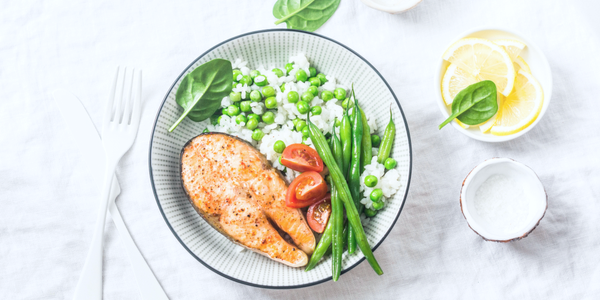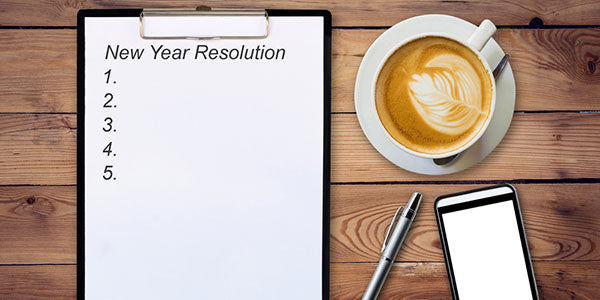
With supersizing and inexpensive meal upgrades, portion sizes have substantially grown over the years, making it that much easier to overeat on unhealthy foods. The evolution has ultimately misled the view of what portions should actually look like.
The good news portion control tips help combat these growing amounts of food. Such simple tweaks and tricks help control calories while optimizing nutrient intake.
Ensure portion control for weight loss and healthy eating with this food portion guide created by dietitians. Not only are the portion control tips simple, but proven to be effective!
Portion Control for Weight Loss
From drinking more water to using portion control tools, learn how to eat smaller portions to lose weight.
1. Use Portion Control Tools & Containers
Portion control tools are helpful for measuring and ensuring proper portions for dieters alike. These tools come in a wide variety, including portion control plates, spoons, and scales.
Portion control plates are often color-coded to allocate portions of the plate to certain food groups, including lean protein, fruits, vegetables, and healthy fats. Portion control containers also tend to be durable, helpful for meal prep food storage, dishwasher-safe, and BPA-free.
A meal delivery service, such as bistroMD can also be useful for learning how a proper portion size should look like. This is because meals are properly portioned and combine the right nutrients to keep the body satisfied and feel full for hours!
2. Drink More Water
Keeping the body hydrated is important for weight loss in a number of ways, including sustaining vital metabolic functions. Dehydration can also be mistaken for hunger, which may lead to food intake when the body is actually craving water.
So instead of quickly reaching for food, drink a big glass of water then truly gauge if feeling hungry.
Though everyone is different in how much water their body needs to stay hydrated, aim for about 64 ounces daily. Tips to drink more water include:
• Use larger water bottles and cups.
• Enhance the flavor with freshly squeezed lemon and other flavorings.
• Make water convenient, including leaving a water bottle in the car.
All in all, designate water as the primary hydration source and limit beverages filled with added sugar and other unwanted ingredients.
3. Load Up with Veggies
"Fill up your plate!" is not often recommended when trying to cut calories and lose weight. However, non-starchy veggies such as salad greens, carrots, and peppers are low in calories but abundant in nutrients.
Filling up the plate with veggies can ultimately lead to filling up the stomach without feelings of guilt. Delicious ways to eat more veggies include creating a balanced salad, sneaking into recipes such as smoothies, and trying unique methods to enjoy them such as a delicious mashed cauliflower with mushrooms.
4. Use Small Plates
From an early age, it was typically rooted to "finish your plate" before excusing yourself from the dinner table. Though finishing everything on the plate reduces food waste, following that notion can result in overeating, and eventually weight gain, if meals are served on larger plates.
To keep portions in check, use smaller plates for mealtimes. Also when plating, notice how much room the food takes up while considering most of these tips, including loading up on veggies and balancing the plate with protein (see tip #7).
5. Split Restaurant Meals
Although you may be getting more bang for your buck, restaurant plates tend to be quite generous. Some meals may even be double or three times more than a recommended serving.
To avoid trying to finish the plate and overeating calories, split with someone else at the table. Ask for a to-go box upfront and half the meal before eating - some servers will even split the meal for you!
6. Compare Portions to Day-to-Day Objects
Unless filled with culinary experience, knowing what half a cup of pasta looks like without a measuring cup is challenging. Besides, carrying and using a food scale everywhere is also not practical.
For these reasons, try to compare serving sizes to common objects and sizes. Knowing these eyeball measurements can be particularly useful when food labels and tools are not convenient. Use a food portion guide to learn common portion sizes as well.
7. Pass On Restaurant Freebies
Some restaurants serve bread and chips as soon as you reach your seat. If you personally know you will have zero self-control to turn them down, let the server know to not bring over the freebies.
If other table members want them, place the food items closer to their seats to reduce their enticement.
8. Scope the Buffet
With numerous options and endless trips, the buffet screams poorer food and health choices. So before loading up your plate at the beginning, see what types of foods are offered throughout the entire buffet.
Make a mental game plan and go for nourishing foods the first go-round, which may be the salad bar. However, be cautious of high-calorie options such as dressings and croutons.
A balanced plate at the buffet may resemble the following:
• Leafy greens and non-starchy veggies filling at least half the plate.
• A light drizzle of olive oil or a few pecans to top onto the salad greens.
• Three to four ounces of lean protein such as grilled chicken, sirloin, or fish.
• A baked potato, whole wheat pasta, or dinner roll that takes up about a quarter of the plate.
9. Work for Your Food
Choose food and snack items that need a little extra work beyond opening a chip bag and sleeve of cookies. Oranges and shelled nuts are a few ideas requiring little work and can slow down the eating process.
10. Say "No" to the Bag
Most do not realize a serving size is typically a smaller portion, not the entire chip bag. If you plan to go for packaged foods, be sure to stick to the portion size denoted on the nutrition label.
Measure out a proper serving, place in a separate bowl, and put up the bag or box. This lowers the temptation for more servings.
11. Practice Mindful Eating
Mindful eating is increasing in popularity for weight loss and portion control. Instead of focusing on the quantity of food, mindfulness promotes listening to the body's natural hunger and satiety cues.
The practice also encompasses an "all-foods-fit" approach, meaning you can enjoy that scoop of ice cream! Tips for mindful eating include the following:
• Eat and chew foods slowly
• Put the fork down between each bite
• Avoid distractions while eating such as the television or phone
• Tune into internal hunger and satiety cues
• Recognize the present external world
• Appreciate the food at hand
Taken together, the practice encourages one to truly savor the experience of food by tuning into internal and external cues.
Concluding Portion Control for Weight Loss
True and sustainable weight loss takes time, patience, and consistency and requires dietary attention. In addition to focusing on nutrient-dense foods, practicing portion control for weight loss can be one of the best ways to reach and surpass health goals.
Simple yet effective portion control tips include using portion control containers and other tools, knowing how to balance a meal plate, and dining out with a game plan. Practicing mindful eating and taking advantage of pre-portioned meals from a weight loss delivery service can also be highly beneficial for enjoying delicious food while losing weight.







